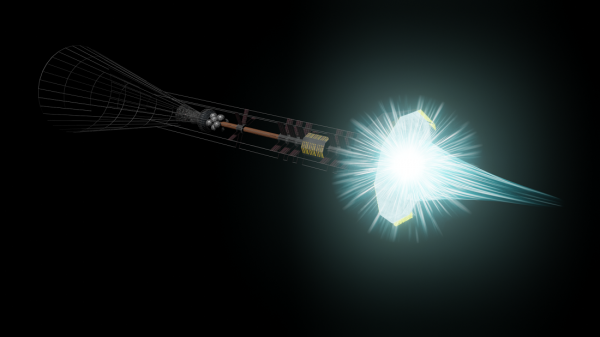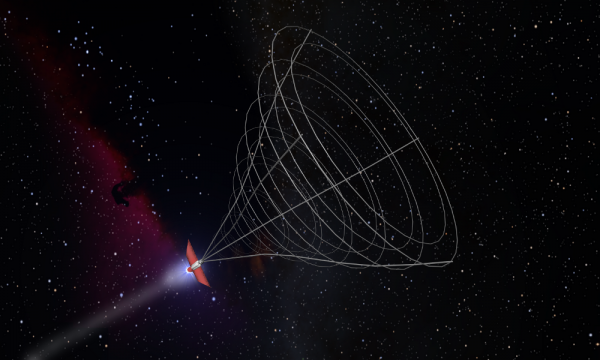BY LETTER
Ramscoop and RAIR ships
Technology > Technology Levels > High Tech / Hitech
Technology > Application > Transportation > Interplanetary Transport
Technology > Application > Transportation > Interstellar Transport
Technology > Application > Transportation > Propulsion Technology
Technology > Application > Transportation > Interplanetary Transport
Technology > Application > Transportation > Interstellar Transport
Technology > Application > Transportation > Propulsion Technology
The Bussard Ramscoop concept, Ram Augmented Interstellar Rocket ships and other Magnetic Scoop devices | |
 Image from Lilly Harper | |
| This Ram Augmented Interstellar Rocket (RAIR) ship collects interstellar hydrogen to use as propellant but carries its own fuel separately. | |
The original concept
The Bussard Ramscoop, or Ramjet, was proposed in 9 BT by the fusion pioneer Robert W Bussard as a method of collecting hydrogen from the interstellar medium and fusing it to provide thrust; he suggested that this process would eliminate the need for fuel on board the craft and be self-sustaining, allowing for practically continuous acceleration. Bussard recognised that the interstellar medium was very thin, so his projected craft would not be able to collect enough hydrogen at low speeds; it was suggested that the ramscoop would need to exceed 6% of lightspeed to provide acceleration, and that a magnetic scoop would be required, to save mass.Because interstellar dust and hydrogen is not strongly charged, a powerful forward pointing laser is necessary to ionise the material and allow it to be collected by the scoops.
Use in braking
Later work showed that the drag experienced by a ship with a magnetic scoop thousands of kilometres wide would be so great that no acceleration would be possible. This inspired the magnetic parachute braking system, used by high-speed craft in the outer solar system from 210 A.T. onwards, and incorporated into most of the pioneering interstellar ships in one form or another.Collecting the interstellar medium, slowing it down and using the kinetic energy collected to power the magnetic ramscoop caused so much deceleration that interstellar probes and spacecraft were able to save a great deal of fuel in the deceleration phase; this translated to a much greater saving in the fuel required for acceleration, and made interstellar craft of all designs much lighter. Many interstellar craft used the collected hydrogen and dust as mass for further deceleration, once the craft was no longer travelling at speeds sufficient to cause deceleration by friction. Other designs filled the magnetic parachute field with collected dust, and used it as a magsail for braking against the local stellar proton wind.
 Image from Steve Bowers | |
| In certain designs the interstellar medium can be used as fuel, often in a reaction with on-board fuel supplies, antimatter or monopoles | |
Ram Assisted Interplanetary (or Interstellar) Rockets (RAIR)
The ideal of obtaining free fuel from space was not abandoned, however; in the later interplanetary age the outer Solar system was filled with RAIR ships, Ram Assisted Interplanetary (or interstellar) Rockets; this was conceived as an interstellar design but works most efficiently in the dusty zodiacal clouds of a solar system. The RAIR ship has large fuel reserves; the fuels utilised in the Interplanetary age included deuterium and Helium3, sometimes tritium. Interplanetary (or interstellar) dust and hydrogen collected by the relatively small ramscoop is used as inert propellant mass, while conserving as much of the kinetic energy of the medium as possible to avoid braking effects.Several late interplanetary age and early Federation age exploration ships used a Seeded Ramscoop system; pellets of frozen hydrogen and other catalytic elements were sprayed into the path of RAIR ships on interstellar paths; these pellets were launched by mass driver catapult along the expected path of the manned ship; insulated inside lightweight hulls, they were vaporised remotely only when the forward laser beam of the oncoming craft was detected. Some designs rely on catapulted fuel captured from behind; this resembles Beamrider technology in some ways, in that the fuel transfers momentum to the ship when in acceleration mode.
Catalysis of fusion using Hydrogen/Boron and Hydrogen/Lithium reactions allows for the hydrogen in the collected material to be fused as well; proton/proton fusion can be also catalysed using carbon and neon, muon catalysis, or by antimatter excitation; the first spacecraft using antimatter for propulsion used it to catalyse hydrogen fusion, which allowed a small amount of fabulously expensive antimatter to produce more energy than by basic annihilation.
 Image from Copyright Lilly Harper |
Image from Steve Bowers and Juan Ochoa | |
| Conversion drive RAIR near Green in the Beta Virginis system | |
Even more powerful than antimatter catalysis of fusion, more modern interstellar RAIR craft use matter/antimatter annihilation of collected interstellar hydrogen.The most efficient S:0 drives are complicated hybrid designs meant for one-way trips. Such designs consist of an antimatter-powered ramscoop coupled with a lightsail. The flight profile consists of a laser boost phase to 0.2-0.3c, where the ramscoop gathers reaction matter for the antimatter reaction.To avoid magnetic braking effects these reactions are carried out in long thin reaction tubes running the length of the craft, without slowing the interstellar medium in the forward component as much as possible.
The vessel boosts up to about 0.7c and coasts. To decelerate at the far end of the journey, the ramscoop is used for braking, combined with the lightsail used in a stardive maneuver and a small amount of remaining antimatter. Due to lack of effective shielding, such designs are sharply constrained by erosion to little more than 100 lightyears in range. This is about the best performance an S:0 design is capable of.
Transapient Conversion Drive technology (a so-called 'Gift Drive') allows a ramscoop ship to convert the collected mass more or less directly into energy, without the need for stored antimatter. Since the Version War most relativist clades have incorporated RAIR mass collection into their interstellar ships to augment the fuel reserves; they are particularly useful in molecular clouds and nebulae. The combination of Conversion Drive and ram-collection allows a modern ramscoop vessel essentially unlimited range and such vessels can achieve very high fractions of the speed of light.
Optical Ramscoops
Another development is the optical ramscoop: Use a laser to 'levitate' rings of mirrors ahead of your ship. The mirrors are angled to reflect light in toward the center of the ring. In the process they create an 'optically thick' region of space that pushes the hydrogen into the central region where it is sucked up by the spacecraft and converted into energy by Conversion technology for remarkable power/thrust.The biggest drawback is that you would need about 1500TW of power to run the laser, which also can be provided by direct matter/energy conversion.
Bussard ramscoops are also utilised in inner solar systems to sweep dust away from inhabited regions; beanstalks and other megastructures are vulnerable to micrometeorite impact, so the disruption caused by periodic magnetic dust collection is considered worthwhile.
 Image from Steve Bowers |
Related Articles
Appears in Topics
Development Notes
Text by Steve Bowers, Tim Weaver and Todd Drashner
Initially published on 08 December 2008.
Initially published on 08 December 2008.
Additional Information
Image 'RAIR Ship' copyright by Lilly Harper used with permission. Please contact her for conditions of re-use at at https://beaconsinthedark.wordpress.com/.






